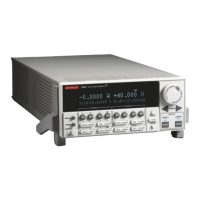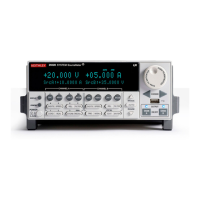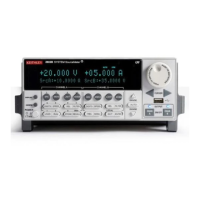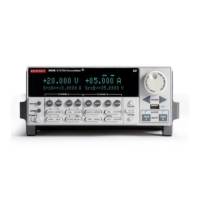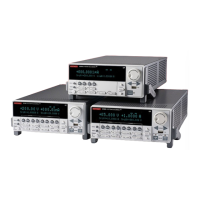5 -7
SECTION 5
Using Substrate Bias
FET _ Comm _ Source _ Vsb(1, 12, 10, 1, 12,
80, –2)
to the instrument.
The sources will be enabled, and the substrate bias is applied, 10.
the gate-source voltage value is applied, and the drain-source
sweep is executed. The gate-source voltage value is then incre-
mented and the drain-source sweep is re-run.
Once the gate-source sweep has been completed, the data 11.
(V
SB
, V
GS
, V
DS
, and I
D
) will be presented in the Instrument
Console window of TSB.
5.3.8 Typical Program 13 Results
Figure 5-6 shows a typical plot generated by Example
Program 13.
5.3.9 Program 13 Description
Both instruments are returned to default conditions. Node 1
SMUB, which sweeps V
GS
, is configured as follows:
Source V•
1mA compliance, autorange•
Local sense•
vgsstart
• : 0V
vgsstop
• : 10V
vgssteps
• : 5
Next, Node 1 SMUA, which sweeps V
DS
and measures I
D
, is set up
to operate in the following manner:
Source V•
Local sensing•
100mA compliance, autorange measure•
1 NPLC Line cycle integration•
vdsstart
• : 0V
vdsstop
• : 10V
vdssteps
• : 100
Finally, Node 2 SMUA, which provides substrate bias, is pro-
grammed as follows:
Source V•
Local sensing•
10mA compliance, autorange measure•
Both instruments are returned to default conditions; the sources
are zeroed and enabled. The substrate bias (V
SB
) and gate-source
(V
GS
) are applied and the program enters the main program loop
to perform five I
D
vs. V
DS
sweeps, one for each of five V
GS
values.
Node 1 SMUA then cycles through its sweep list, setting V
DS
to the
required values, and measuring I
D
at each step along the way. The
program then loops back for the next sweep until all five sweeps
have been performed.
Next, all three SMU outputs are zeroed and disabled. Finally, the
data is written to the Instrument Console of the TSB.
5.3.10 Modifying Program 13
For different sweeps, the V
GS
start, V
GS
stop, V
GS
steps, V
DS
start,
V
DS
stop, and V
DS
steps values can be changed as required. For
different sweep lengths, array size and loop counter values must
be adjusted accordingly.
5.4 BJT Substrate Biasing
The following paragraphs discuss using one dual-channel and
one single-channel Series 2600 System SourceMeter instrument
to perform tests on a four-terminal device, such as a BJT, with
substrate bias. The example shown in this section is a modified
version of the common-emitter BJT test presented previously in
the guide.
5.4.1 Program 14 Test Configuration
Figure 5-7 shows the test configuration for Program 14. Node 1
SMUB is used to sweep I
B
, while Node 1 SMUA sweeps V
CE
and
measures I
C
. Node 2 SMUA applies the substrate bias (V
SB
) to the
device under test.
5.4.2 Example Program 14: Common-
Emitter Characteristics with a
Substrate Bias
Program 14 demonstrates common-emitter characteristic test pro-
gramming with substrate bias. Proceed as follows:
With the power off, connect the dual-channel System Source-1.
Meter instrument to the computer’s IEEE-488 interface. Con-
nect the single-channel System SourceMeter instrument to the
dual-channel master using a crossover Ethernet cable.
Connect the test fixture to both units using appropriate 2.
c a b l e s .
Turn on the instruments and allow the units to warm up for 3.
two hours for rated accuracy.
Configure the TSP-Link communications for each instrument.4.
Slave: A single-channel instrument such as the Model 2601,
2611, or 2635.
1. Press the MENU key to access MAIN MENU.

